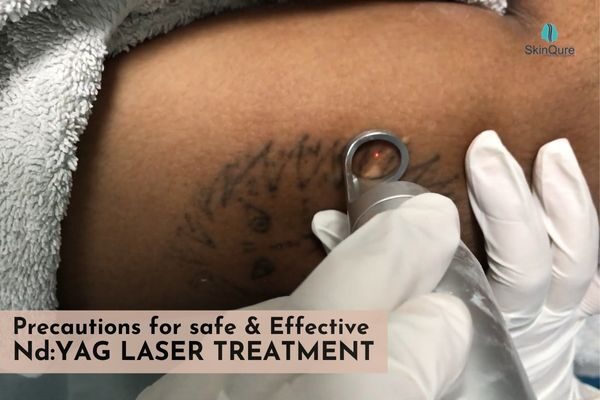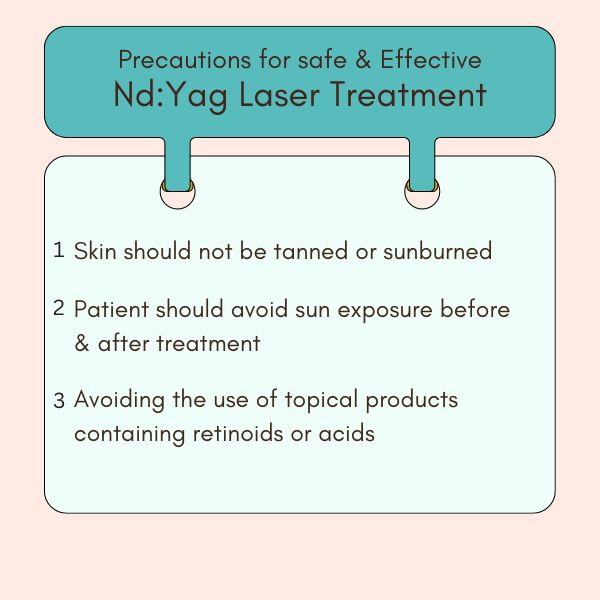
In recent years, Nd: YAG laser treatment has emerged as a revolutionary technology in the field of medical aesthetics. This non-invasive procedure utilizes a solid-state laser to address dermatological concerns with exceptional precision and minimal downtime. While the procedure offers numerous benefits, it is essential to understand the precautions associated with Nd: YAG laser treatment to ensure optimal outcomes and patient safety.
Nd: YAG laser treatment involves the utilization of a neodymium-doped yttrium aluminum garnet (Nd: YAG) crystal that emits a high-energy laser beam. This laser has a longer wavelength than other lasers, allowing it to penetrate deeper layers of the skin, making it ideal for various procedures. Nd: YAG laser treatment is commonly employed for hair removal, treatment of vascular lesions (such as spider veins and varicose veins), tattoo removal, skin rejuvenation, and pigmented lesion removal. The laser’s energy is absorbed by the target tissue, leading to controlled thermal damage and subsequent healing responses.
Precautions for Patients

- Prior to undergoing Nd: YAG laser treatment, patients should follow several precautions to maximize safety and efficacy. First and foremost, patients must disclose their medical history, including any underlying skin conditions, allergies, or medications they are currently taking. This information enables the practitioner to assess the patient’s suitability for the procedure and make necessary adjustments to treatment parameters.
- Patients should also avoid sun exposure and tanning beds before their Nd: YAG laser treatment session. Excessive sun exposure can increase the risk of post-treatment complications, such as hyperpigmentation or blistering. Furthermore, patients should discontinue any photosensitizing medications, as they may heighten the skin’s sensitivity to light and potentially lead to adverse reactions during the procedure.
- It is crucial for patients to adhere to the pre-treatment instructions provided by the practitioner. These may include avoiding the use of topical products containing retinoids or acids, as they can cause skin sensitivity. Patients should arrive at the treatment session with clean skin, free of makeup, creams, or lotions, to ensure optimal laser penetration and reduce the risk of unwanted side effects.
Precautions for Practitioners
- Practitioners administering Nd: YAG laser treatment must possess the necessary expertise and training to operate the device safely. They should have a comprehensive understanding of the laser’s settings and the specific protocols for different applications. This knowledge enables them to customize treatment parameters based on individual patient characteristics, ensuring the best possible outcomes.
- Moreover, practitioners must conduct a thorough assessment of each patient’s skin type and condition prior to treatment. This evaluation helps determine the appropriate laser settings and reduces the risk of complications, such as burns or scarring.
- Practitioners should also prioritize eye protection for both themselves and the patient. Wearing appropriate laser safety goggles shields the eyes from potential laser exposure, which can cause severe damage. Additionally, maintaining clear and concise communication with the patient throughout the procedure is crucial to ensure their comfort and safety.
Conclusion
Nd: YAG laser treatment offers remarkable precision and versatility in addressing a range of dermatological concerns. However, it is vital for both patients and practitioners to observe precautions to achieve optimal results and maintain safety. By following pre-treatment guidelines, disclosing medical history, and employing appropriate protective measures, patients can minimize potential risks and enhance the procedure’s effectiveness. at SkinQure, we provide advanced and FDA-approved laser treatment in Saket, South Delhi.
FAQs on Nd:YAG Laser Treatment
Ques1. What is Nd: YAG laser treatment, and how does it work?
Ans1. Nd: YAG laser treatment is a medical procedure that uses a specific type of laser called Neodymium-doped Yttrium Aluminum Garnet (Nd: YAG) to target various skin concerns. This laser emits a wavelength of light that can penetrate deep into the skin, allowing it to target specific structures like blood vessels, hair follicles, or pigmented lesions.
Ques2. What conditions can be treated with Nd: YAG laser?
Aans2. Nd: YAG laser treatment can effectively address various skin conditions, including vascular lesions (such as spider veins, hemangiomas, or rosacea), pigmented lesions (like age spots, sunspots, or freckles), hair removal, tattoo removal, skin rejuvenation and onychomycosis (nail fungus).
Ques3. Is Nd: YAG laser treatment safe?
Ans3. When performed by a trained professional, Nd: YAG laser treatment is considered safe. However, like any medical procedure, there are potential risks and side effects associated with the treatment. These may include tem
Ques4. How long does a typical Nd: YAG laser treatment session last, and how many sessions are needed?
Ans4. The duration of an Nd: YAG laser treatment session can vary depending on the area being treated and the specific condition. A session may last anywhere from a few minutes to an hour. The number of sessions required will also depend on factors such as the condition being treated, its severity, and your individual response to the treatment.
Ques5. What should I expect during and after Nd: YAG laser treatment?
Ans5. During the treatment, you will be provided with appropriate eye protection, and the laser handpiece will be directed to the target area. You may experience some mild discomfort or a warming sensation during the procedure, but it is generally tolerable. After the treatment, you may notice temporary redness, swelling, or darkening of the treated area. These effects typically subside within a few days to a couple of weeks.
